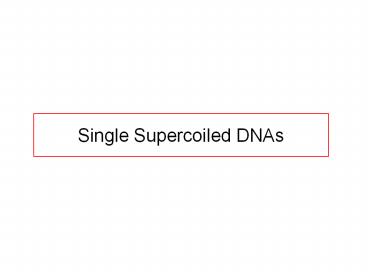Single Supercoiled DNAs - PowerPoint PPT Presentation
Title:
Single Supercoiled DNAs
Description:
Single Supercoiled DNAs DNA Supercoiling in vivo In most organisms, DNA is negatively supercoiled (s ~ -0.06) Actively regulated by topoisomerases, ubiquitous and ... – PowerPoint PPT presentation
Number of Views:61
Avg rating:3.0/5.0
Title: Single Supercoiled DNAs
1
Single Supercoiled DNAs
2
DNA Supercoiling in vivo
- In most organisms, DNA is negatively supercoiled
- (s -0.06)
- Actively regulated by topoisomerases, ubiquitous
and essential family of proteins - Supercoiling is involved in DNA packaging around
histones, and the initiation of transcription,
replication, repair recombination - Known to induce structural changes in DNA
- Traditional means of study (gel electrophoresis,
sedimentation analysis, cryo-EM) do not provide
for time-resolved, reversible studies of DNA
supercoiling
3
Topological formalism for torsionally constrained
DNA
Tw (Twist, the number of helical turns of
the DNA) Wr (Writhe, the number of loops
along the DNA) _____ Lk (Total number of
crossings between the 2 strands)
Linking number for torsionally relaxed DNA Lko
Two (Two 1 per 10.5 bp of B-DNA, Wro
0) Linking number for torsionally strained
DNA DLk Lk-Lko DTw Wr Normalized linking
number difference s DLk /Lko
4
How to torsionally constrain DNA?
DNA must be 1) unnicked and 2) unable to rotate
at its ends
5
Magnetic Trap
6
Depth Imaging
7
One molecule or two molecules?
8
Extension vs. Supercoiling
9
(No Transcript)
10
Supercoiling and the buckling transition
11
Is DNA stretched and supercoiled in vivo or in
solution?
- Relationship between plasmid and extended DNA.
Circular l-DNA with s -0.05 experiences
an internal (entropic) tension 0.3 pN
12
Temperature-dependence of DNA helicity
As the temperature increases the DNA helicity
progressively increases (i.e. the angle between
base pairs increases).
Raising the temperature by 15oC causes l-DNA to
unwind by 25 turns
?DNA unwinds by 0.012o/oC/bp
13
Force-extension curves for SC-DNA
14
Effect of ionic conditions
15
Evidence for DNA unwinding hybridization
experiments
3
16
Hybridization force and hat curve detection
17
Sequence/Supercoiling dependence of hybridization
18
Measuring DNA Unwinding Energeticsusing
low-force data
scDNA
-scDNA
19
Paths to Stretched Overwound DNA
TA WAB WAB TB
TA DWAB TB
20
Paths to Stretched, Unwound DNA
A- A
DWAB-
TA- DWAB- TB-
21
Denaturing DNA before the buckling transition
(2pnc)2 Ed
TB-
22
Measuring the Work Deficit to Stretch Unwound DNA
A- A
DWAB-
Symmetry of plectoneme formation TA- TA
D DWAB - DWAB- TB - TB-
23
Determination of DNA twist persistence
length,critical torque for unwinding, and
energy of denaturation
kBT C
(2pnc)
-
9 pN nm
Gc
lo
24
High-force properties of supercoiled DNA
Negative Supercoiling
Positive Supercoiling
S-DNAP-DNA
S-DNA
Leger et al., PRL (1999) 83 1066-1069
25
DNA the compliant polymorph
B-DNA 10.4 bp/turn 3.3 nm pitch
P-DNA 2.5 bp/turn 1.5nm/bp
S-DNA 38 bp/turn 22 nm pitch
Images R. Lavery using JUMNA
26
Effect of torque on transition rates
a aoexp(2pDnnativeG/kBT)
b bo exp(-2pDnunwoundG/kBT)































